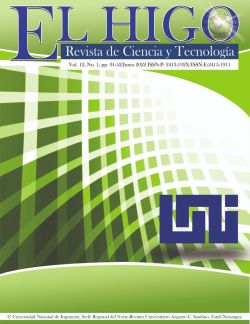Importance of fats and oils in the diet and the effects of the frying operation on food safety
DOI:
https://doi.org/10.5377/elhigo.v12i1.14525Keywords:
lipids, toxicity of oils, acrylamide, acroleinAbstract
Fats and oils are an important part of the daily diet. The fatty acids perform biological functions and its ingestion in an adequate omega-6/omega-3 ratio can contribute to a healthy condition. This article is a review of the health implications related to the ingestion of unsaturated, saturated and trans fatty acids. In addition, the parameters that affect the toxicity and safety of oils and fats due to industrial processes are described. Likewise, the toxic substances that can be formed during the heating of the oils and the effects of their consumption on the human body were researched. From this, it is recommended that during the frying process the temperature should be controlled to carry out the operation below 170 °C. The removal of food scraps from the containers used in frying and from the reuse oil is also suggested. To prevent the inhalation of smoke generated during the frying process, the installation of ventilation devices and extractors is recommended, in order to contribute to the reduction of risks for human health.
Downloads
References
Belkacemi, K., Boulmerka, A., Arul, J., y Hamoudi, S. (2006). Hydrogenation of Vegetable Oils with Minimum trans and Saturated Fatty Acid Formation Over a New Generation of Pd-catalyst. Topics in Catalysis, 37(2–4), 113–120. https://doi.org/10.1007/s11244-006-0012-y
Berry, S. E., Bruce, J. H., Steenson, S., Stanner, S., Buttriss, J. L., Spiro, A., Gibson, P. S., Bowler, I., Dionisi, F., Farrell, L., Glass, A., Lovegrove, J.
A., Nicholas, J., Peacock, E., Porter, S., Mensink, R. P., y L Hall, W. (2019). Interesterified fats: What are they and why are they used? A briefing report from the Roundtable on Interesterified Fats in Foods. Nutrition Bulletin, 44(4), 363–380. https://doi.org/10.1111/nbu.12397
Castejon, L. V., Delalibera, J. R., y Finzer, F. (2010). Estudo da transferência de massa no processo de fritura. FAZU Em Revista, Uberaba, 7, 139–144.
Chang, C.-Y., Ke, D.-S., y Chen, J.-Y. (2009). Essential fatty acids and human brain. Acta Neurologica Taiwanica, 18(4), 231–241. http://www.ncbi.nlm.nih.gov/pubmed/20329590
Chaves, H., Singh, R. B., Khan, S., Wilczynska, A., y Takahashi, T. (2019). High Omega-6/Omega-3 Fatty Acid Ratio Diets and Risk of Noncommunicable Diseases. En: R. B. Singh, R. Watson, y T. Takahashi (Eds.), The Role of Functional Food Security in Global Health (pp. 217–259). Elsevier. https://doi.org/10.1016/B978-0-12-813148-0.00014-1
Chen, Y. C., y Chen, B.-H. (2003). Determination of Polycyclic Aromatic Hydrocarbons in fumes from fried chicken legs. Journal of Agricultural and Food Chemistry, 51(14), 4162–4167. https://doi.org/10.1021/jf020856i
Choe, E., y Min, D. B. (2007). Chemistry of deep-fat frying oils. Journal of Food Science, 72(5), R77–R86. https://doi.org/10.1111/j.1750-3841.2007.00352.x
Falade, A. O., Oboh, G., Ademiluyi, A. O., y Odubanjo, O. V. (2015). Consumption of thermally oxidized palm oil diets alters biochemical indices in rats. Beni-Suef University Journal of Basic and Applied Sciences, 4(2), 150–156. https://doi.org/10.1016/J.BJBAS.2015.05.009
FAO/WHO. (2021). Standard for Named Vegetable Oils Cxs 210-1999. Organización de Las Naciones Unidas Para La Agricultura y La Alimentación/Organización Mundial de La Salud. https://www.fao.org
Firestone, D. (2007). Regulation of Frying Fat and Oil. En: Deep Frying (pp. 373–385). Elsevier. https://doi.org/10.1016/B978-1-893997-92-9.50027-X
Freire, P. C. M., Mancini-Filho, J., y Ferreira, T. A. P. de C. (2013). Principais alterações físico-químicas em óleos e gorduras submetidos ao processo de fritura por imersão: regulamentação e efeitos na saúde. Revista de Nutrição, 26(3), 353–358. https://doi.org/10.1590/S1415-52732013000300010
Gertz, C., y Klostermann, S. (2002). Analysis of acrylamide and mechanisms of its formation in deep-fried products. European Journal of Lipid Science and Technology, 104(11), 762–771. https://doi.org/10.1002/1438-9312(200211)104:11<762::AID-EJLT762>3.0.CO;2-R
Hammad, S., Pu, S., y Jones, P. J. (2016). Current Evidence Supporting the Link Between Dietary Fatty Acids and Cardiovascular Disease. Lipids, 51(5), 507–517. https://doi.org/10.1007/s11745-015-4113-x
Jiang, D., Wang, G., Li, L., Wang, X., Li, W., Li, X., Shao, L., y Li, F. (2018). Occurrence, dietary exposure, and health risk estimation of polycyclic aromatic hydrocarbons in grilled and fried meats in Shandong of China. Food Science & Nutrition, 6(8), 2431–2439. https://doi.org/10.1002/fsn3.843
Jiang, H., Chen, W., Jia, Z., y Tao, F. (2020). Physiochemical properties of short-term frying oil for chicken wing and its oxidative stability in an oil-in-water emulsion. Food Science & Nutrition, 8(1), 668–674. https://doi.org/10.1002/FSN3.1355
Kehrer, J. P., y Biswal, S. (2000). The Molecular Effects of Acrolein. Toxicological Sciences, 57(1), 6–15. https://doi.org/10.1093/toxsci/57.1.6
Kitts, D. D. (2005). Toxicity and Safety of Fats and Oils. En: F. Shahidi (Ed.), Bailey’s Industrial Oil and Fat Products (Sexta Edición), pp. 513–564). John Wiley & Sons.
Macri, E. V., Ramos, C., Bozzini, C., Zago, V., Giacomino, S., Pellegrino, N., Boyer, P. M., Lifshitz, F., y Friedman, S. M. (2019). Fried sunflower oil intake affects bone quality, in growing rats. Current Research in Nutrition and Food Science, 7(1), 52–65. https://doi.org/10.12944/CRNFSJ.7.1.06
Marques, A. y C., Valente, T. B., y Rosa, C. S. da. (2009). Formação de toxinas durante o processamento de alimentos e as possíveis conseqüências para o organismo humano. Revista de Nutrição, 22(2), 283–293. https://doi.org/10.1590/S1415-52732009000200010
Moghe, A., Ghare, S., Lamoreau, B., Mohammad, M., Barve, S., McClain, C., y Joshi-Barve, S. (2015). Molecular Mechanisms of Acrolein Toxicity: Relevance to Human Disease. Toxicological Sciences, 143(2), 242–255. https://doi.org/10.1093/toxsci/kfu233
Park, J. M., Koh, J. H., y Kim, J. M. (2020). Determining the reuse of frying oil for fried sweet and sour pork according to type of oil and frying time. Food Science of Animal Resources, 40(5), 785–794. https://doi.org/10.5851/kosfa.2020.e54
Sebastian, A., Ghazani, S. M., y Marangoni, A. G. (2014). Quality and safety of frying oils used in restaurants. Food Research International, 64, 420–423. https://doi.org/10.1016/j.foodres.2014.07.033
Simopoulos, A. (2016). An Increase in the Omega-6/Omega-3 Fatty Acid Ratio Increases the Risk for Obesity. Nutrients, 8(3), 128. https://doi.org/10.3390/nu8030128
Sousa, E., Pereira Jr, A., Silva, G., y Marques, A. (2014). Avaliação da qualidade de óleos de origem vegetal oriundos de frituras. Acta Tecnológica, 9(2), 58–62. https://doi.org/10.35818/acta.v9i2.285
Tadesse Zula, A., y Fikre Teferra, T. (2022). Effect of frying oil stability over repeated reuse cycles on the quality and safety of deep-fried Nile tilapia fish ( Oreochromis niloticus ): a response surface modeling approach. International Journal of Food Properties, 25(1), 315–325. https://doi.org/10.1080/10942912.2022.2034851
Valenzuela B, A. (2008). Ácidos grasos con isomería trans I: su origen y los efectos en la salud humana. Revista Chilena de Nutrición, 35(3), 162–171. https://doi.org/10.4067/S0717-75182008000300001
Vieira, S. A., Zhang, G., y Decker, E. A. (2017). Biological Implications of Lipid Oxidation Products. Journal of the American Oil Chemists’ Society, 94(3), 339–351. https://doi.org/10.1007/s11746-017-2958-2
Wanders, A., Zock, P., y Brouwer, I. (2017). Trans Fat Intake and Its Dietary Sources in General Populations Worldwide: A Systematic Review. Nutrients, 9(8), 840. https://doi.org/10.3390/nu9080840
World Food Programme. (2021). Technical Specifications for: Vegetable oil – Virgin olive oil. WFP. https://docs.wfp.org/api/documents/WFP-0000129850/download/
Yao, Z., Li, J., Wu, B., Hao, X., Yin, Y., y Jiang, X. (2015). Characteristics of PAHs from deep-frying and frying cooking fumes. Environmental Science and Pollution Research, 22(20), 16110–16120. https://doi.org/10.1007/s11356-015-4837-4
Yasuhara, A., Tanaka, Y., Hengel, M., y Shibamoto, T. (2003). Gas Chromatographic Investigation of Acrylamide Formation in Browning Model Systems. Journal of Agricultural and Food Chemistry, 51(14), 3999–4003. https://doi.org/10.1021/JF0300947
Downloads
Published
How to Cite
Issue
Section
License
Copyright (c) 2022 Universidad Nacional de Ingeniería

This work is licensed under a Creative Commons Attribution-NonCommercial-NoDerivatives 4.0 International License.







